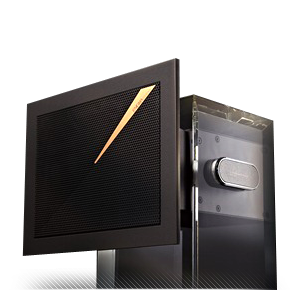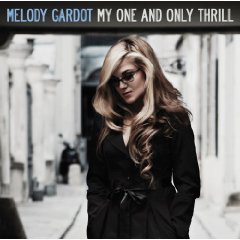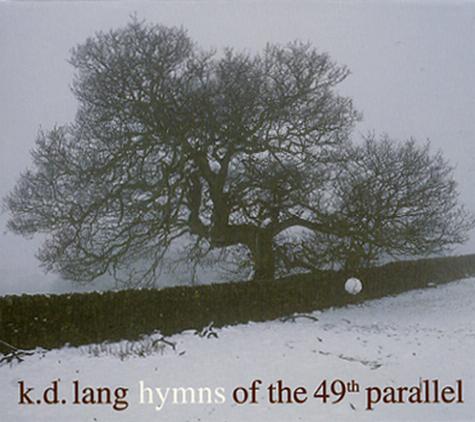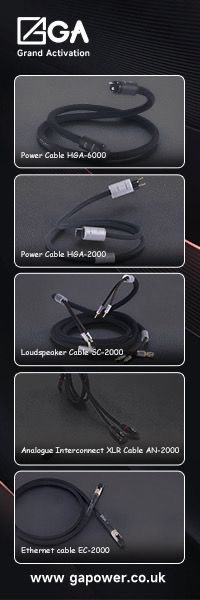EnigmAcoustics Electrostatic Super Tweeter

Take Your System to New Sonic Heights
While wandering the halls of CES 2013 searching for enlightenment I entered the room of a company I had never heard of and was immediately intrigued. ENIGMAcoustics was proudly displaying their Sopranino Self-Biased Electrostatic Loudspeaker (SBESLTM) super tweeters perched atop a pair of Magico V3s. Electrostatic super tweeters I muttered—that’s unique. Those thoughts were quickly followed by HMMM, my Quad ESL-2805s are electrostatic and some of my all-time favorite speakers include exotic higher frequency tweeters. I wonder how those classy looking super tweeters would work with Quads. I eventually determined they work quite well with a variety of speaker designs. But I am getting ahead of myself, read on.
Before I could sit down, a cheerful ENIGMAcoustics’ employee informed me that self-biased means ENIGMAcoustics had developed a method to permanently implant charges on a non-conductive film with a special molecular structure serving as a charge holder. Product literature further explained that this breakthrough design of the diaphragm eliminates the need for a high voltage power source and radically reduces the size and complexity of the speaker. The resulting ultra-light diaphragm is one tenth the thickness of a human hair and carries a constant number of static electric charges to reduce the phenomenon of intermodulation distortion experienced with conductive diaphragms.
Larger, fuller-range electrostatic (ESL) speakers are legendary for speed, transparency and micro dynamics with low distortion. ENIGMAcoustics decided that electrostatic drivers would be the perfect choice to provide reproduction of high harmonics without coloration. But traditional ESL speakers come with a lot of baggage and a “Danger-High Voltage” warning label. Development of the self-biased diaphragm was critical to reducing the complete driver/housing to a simple and safe super tweeter.
The diaphragm is only one part of an ESL driver. Stator plate design is also critical. To maintain maximum transparency stator plates must be as open and thin as possible to permit undistorted penetration of sound waves generated by the diaphragm. At the same time they must maintain maximum rigidity to eliminate vibration. In order to achieve the lowest distortion, superior transient behavior, and optimal resistance to humidity, ENIGMAcoustics designed stators made from a fiberglass substrate for thinness and rigidity and covered with copper for conductivity. The result is a driver with a frequency response that is claimed to vary by less than 2dB.
The stator and diaphragm are housed in a parabolic shaped aluminum enclosure designed for optimum refraction of the dipole back wave. The enclosure is stuffed with acoustic fiber material. The final assembly is mounted on a one-half inch clear glass base. The emphasis is on “clear” because the glass is a special formulation that makes it clear or “white” on the polished edges giving it a crystal appearance compared to standard glass that would have a green tint. The stylish design is contemporary but the clear glass allows it to look at home coupled with any speaker finish.
The only connections to the super tweeters are a pair of speaker cables (not included) that connect the binding posts of the main speakers to the WBT-0763 binding posts on the Sopraninos. The WBTs accept spades (6 or 8mm), banana fittings, or bare wire. To provide flexibility in matching to various speakers, the Sopraninos have an attenuation or gain control switch that allows the user to choose between 90dB or 87dB efficiency. Users can also select from three different frequency settings via a knob at the rear of the unit. Crossover settings are at 8/10/12-KHz each with a slope of 12dB. This is accomplished by a second order crossover consisting of an input capacitor with series inductance. Impedance is relatively flat past 10KHz with the minimum impedance being 3-ohms at 12KHz. Frequency response is reported to be relatively flat to 40KHz with a gentle roll off to 50KHz.
I have to interrupt the technical specifications here to add that the Sopraninos come in some of the classiest packaging I have seen. They are shipped in your standard, boring, heavy-duty cardboard box with foam inserts. The surprise is the beautiful birch plywood box fitted between the foam inserts. Inside the birch box the crystal-clear Sopraninos sit like crown jewels nestled in black velvet cloth over molded foam supports. Of course, like all crown jewels, they should only be handled with white-gloved hands so a pair (gloves, not hands) is included.
Sopraninos are designed to sit directly on top of the main speaker. That does not work with Quads. So, as intrigued with the Sopraninos as I was, I spent the time and money to kludge together some stands. In the audiophile terms they would be described as “custom engineered”. In reality they are merely prototypes of a work-in-progress. I have it on good authority that ENIGMAcoustics is working on theirown custom engineered stand design. Of course they won’t be as nice as mine which are constructed of the very best white pine hand-selected from Home Depot.
Because the Quad power cords and speaker cables are in the way, the stands are just slightly off center. There is no vertical adjustment and the current stands put the base of the Sopranino approximately 2.25 inches above the top of the Quads. I plan to shorten that distance by about 0.75 inches when I disassemble for sanding and painting. The stands do allow for forward and backward adjustment. My placement observations may not hold true for mating the Sopraninos with other types of drivers but matching them to Quads I found slight changes in position front to back were not critical. Final placement was with the front of the Sopraninosparallel to the face of the Quads and slightly behind the cloth covering putting them slightly forward of the Quad’s diaphragm.
In my system Goldilocks would have found the 10KHz and 87dB efficiency settings to be just right. The 8KHz setting imparted too much energy to violins and some female vocal recordings. The 12KHz setting did not seem to do much. The 10KHz/87dB setting imparted a noticeable improvement in sound quality while never imparting a harshness or shrill edge. In that setting, the Sopraninos blended seamlessly with my Quads and never called attention to themselves by beaming or shouting “here I am”. Although I am using my Sopraninos in a set-and-forget mode with a single source, the variable control knob and attenuation switch allow users to tailor the Sopraninos to the current speaker/source/music in use. For example a user might choose one setting for vinyl and another for digital.
Installing the Sopraninos did not seem to do much when I first connected them. I was not surprised since the demo at CES had shown me the changes were subtle and after a few A/B comparisons my mind pretty much abandoned me. No problem, I learned a long time ago that sometimes going backwards is more telling than going forward. I decided to leave the Sopraninos connected for at least a week before doing any additional comparisons beyond adjusting the crossover frequency.
Before I comment on the sonic performance of the Sopraninos I should say a few words for those not familiar with Quad ESL-2805 speakers. The ESL-2805s have a rated sensitivity of 86dB. Either by construction or small size, the ESL-2805s do not share the same ultimate transparency and large soundstage of taller electrostatic speakers. Although the ESL-2805s are transparent, they also have a denser and more compact soundstage than larger ESLs. I prefer Quads precisely for those reasons. I think vocalists, instruments and soundstage are more correctly sized with Quads. And while the Sopraninos did expand the soundstage slightly I welcomed it and did not feel any loss of intimacy. When I state that Sopraninos added more air and extension I do not mean that an instrument or performer became significantly larger. I mean the space around them was expanded and musical notes seemed to reveal their full harmonics. Explaining the difference between some speakers with huge and possibly too diffuse soundstages and the top end air added by the Sopraninos has made this the most difficult review I have ever written. Sopraninos added air and extension by allowing harmonics to expand beyond the imaginary physical boundaries I experienced without them. The concept might sound abstract until it is experienced, at which point both the music and listener’s consciousness have been expanded.
 The effects of the Sopraninos were obvious in multiple areas on the re-release of the Melody Gardot CD My One and Only Thrill [Verve B0013680-02]. On Disc 2 Live in Paris on the track “Ain’t No Sunshine” the Sopraninos added sharpness to the introductory applause. The vibraphone had more sparkle and a longer decay. Horns had more extension and grew. My favorite improvement was the enhanced holographic and haunting aura added to the vocals. At the end of the lines Melody’s voice whispered into nothing like smoke fingers in the wind. In short the Sopraninos offered more extension on both instruments and vocals and gave a better sense of the ambience and space of the liveperformance.
The effects of the Sopraninos were obvious in multiple areas on the re-release of the Melody Gardot CD My One and Only Thrill [Verve B0013680-02]. On Disc 2 Live in Paris on the track “Ain’t No Sunshine” the Sopraninos added sharpness to the introductory applause. The vibraphone had more sparkle and a longer decay. Horns had more extension and grew. My favorite improvement was the enhanced holographic and haunting aura added to the vocals. At the end of the lines Melody’s voice whispered into nothing like smoke fingers in the wind. In short the Sopraninos offered more extension on both instruments and vocals and gave a better sense of the ambience and space of the liveperformance.
 The k.d. lang CD hymns of the 49th parallel [Nonesuch 79847-2] is as dark and dreary as a far-north winter. The one saving grace (appropriate word) is the track “Hallelujah”. Not only did the Sopraninos impart more body and extension to the piano but the extension they added to k.d.’s voice raised it closer to the heavens and rendered more heartfelt passion and an ethereal quality appropriate to the work. The emotional content was significantly enhanced.
The k.d. lang CD hymns of the 49th parallel [Nonesuch 79847-2] is as dark and dreary as a far-north winter. The one saving grace (appropriate word) is the track “Hallelujah”. Not only did the Sopraninos impart more body and extension to the piano but the extension they added to k.d.’s voice raised it closer to the heavens and rendered more heartfelt passion and an ethereal quality appropriate to the work. The emotional content was significantly enhanced.
Gene Ammons blows a mean sax. On “Canadian Sunset” from the Rudy VanGelderremastered release of the CD Boss Tenor [Prestige PRCD-8102-2] the Sopraninos provided more air and extension not just in frequency response but the notes had a longer decay imparting a more fluid presentation. The soundstage expanded and overall the saxophone sounded smoother and more balanced.
Road Trip:
Have super tweeters will travel. To evaluate the Sopraninos on different systems I visited two audio buddies who, if they are not always entirely enthusiastic about my current audio escapade, at least humor me in relative silence and provide food and beverage.
The first adventurous pairing was with 90dB efficient Altec Lansing Flamenco loudspeakers. Yada, yada, yada, ditto all the improvements noted with my Quads. Improvements were obvious and with no downsides but the important takeaway here is the high sensitivity Altec Lansing speakers have a combination midrange/tweeter horn. Blending the electrostatic super tweeters (at the 10KHz/90dB setting) and the horn midrange/tweeters was seamless.
Onward in search of dome tweeters. The next victim was a pair of 94.5dB efficient Audio Note AN-E/SEC Silver loudspeakers. The one-inch dome tweeters in the Audio Note loudspeakers had more hi-frequency energy than the Altec Lansing loudspeakers so it was quickly determined that the 12KHz/90dB setting was optimum for pairing with the Audio Notes. Again similar improvements were experienced but to a lesser degree due to the more powerful Audio Note tweeter and the higher frequency setting on the Sopraninos.
Conclusion:
When I first walked into the ENIGMAcoustics room at CES I thought the Sopraninos would be a perfect match for my ESL speakers. I was correct, the Sopraninos and Quads work beautifully and seamlessly together. I was also somewhat wrong or at least too narrow in my thinking. My conclusions from the road trips are that Sopraninos are not limited by their ESL design. In fact the design is ingenious and quite universal. I found the Sopraninos can be beneficial and predictable additions to various speaker types. Their sonic neutrality, speed and wide dispersion pattern along with the frequency and sensitivity adjustment options make them versatile performers. I was able to easily integrate them with three widely different tweeter designs.
Please understand that since the Sopraninos perform at higher frequencies and are in addition to the primary tweeters they won’t change the overall character of the primary tweeters. If they beam and scream they will continue to beam and scream. However if, like me, you are happy with your current system, the Sopraninos could make a significant improvement. I didn’t think twice before purchasing the review pair to use with my Quads or any successors that may grace my listening room.
Just prior to inserting the Sopraninos I felt my system was sounding the best I had ever heard it. I was a proud papa indeed. Living with the Sopraninos for a while and then disconnecting them left me disappointed with my prior “bestever” system. By comparison, without the Sopraninos it sounded dull and closed in. Not lifeless but with “less life”. The Sopraninos had not just added some extension to the top end. They had expanded the recording venue. In a sense they had knocked down walls or at least moved them. Instruments had more harmonic extension and there was also the feeling that the space around them had been expanded. I was now at least one step closer to reality.
Most equipment reviews focus on frequency balance and tonal purity. With Sopraninos it is not about the amount of high frequency sound that is added. Except for the 8KHz setting the perceived change in the high frequency volume level was minimal or nonexistent. It is more about creating an expansive and fluid top end which I find is a characteristic shared by the best loudspeaker systems.
ENIGMAcoustics is currently working on establishing a network of authorized dealers across North America and the UK/EU. While the dealer network is being established direct sales will be available for areas where there is no dealer.


Specifications: Self-Biased Electrostatic Super Tweeter (26 U.S. patents)
Frequency Response: 8kHz-50kHz
Crossover Frequency: 8/10/12kHz
Crossover Slope: 12dB/Octave
Sensitivity (dB@1m/1W on axis): 90dB or 87dB user selectable
Recommended Power: 50W
Weight (each): 6 pounds
Dimensions (WxHxD): 7.13 x 7.60 x 8.15 inches
Price: $3690 USD (North America) €3000 EUR (UK/EU)
Address: 11 Chrysler
Irvine, CA 92618
Telephone: 949 340 7590
Email: Sales@ENIGMAcoustics.com
Website: WWW.ENIGMACOUSTICS.com
Stereo Times Masthead
Publisher/Founder
Clement Perry
Editor
Dave Thomas
Senior Editors
Frank Alles, Mike Girardi, Russell Lichter, Terry London, Moreno Mitchell, Paul Szabady, Bill Wells, Mike Wright, and Stephen Yan,
Current Contributors
David Abramson, Tim Barrall, Dave Allison, Ron Cook, Lewis Dardick, John Hoffman, Dan Secula, Don Shaulis, Greg Simmons, Eric Teh, Greg Voth, Richard Willie, Ed Van Winkle, Rob Dockery, Richard Doron, and Daveed Turek
Site Management Clement Perry
Ad Designer: Martin Perry





Be the first to comment on: EnigmAcoustics Electrostatic Super Tweeter